BE-955: Managing Cross-cultural Differences in the Workplace Report
VerifiedAdded on 2022/07/26
|13
|2690
|357
Report
AI Summary
This research report, focusing on managing cross-cultural differences in the workplace, explores the impact of globalization on workforce diversity. It examines the rationale behind cross-cultural management, highlighting the importance of understanding cultural differences to avoid misunderstandings and promote creativity. The report outlines the objectives, scope, and research methodology, including the use of secondary data and a case study approach. A comprehensive literature review covers key concepts such as culture, cross-cultural workforce, conflicts, and management, alongside the barriers faced by global managers. The study aims to address research questions concerning the nature of cultural differences, challenges in diverse organizations, and effective management strategies. The expected outcomes include a deeper understanding of intercultural management and practical approaches to minimize conflicts and enhance collaboration in a globalized workplace. The report concludes with a list of references supporting the research.
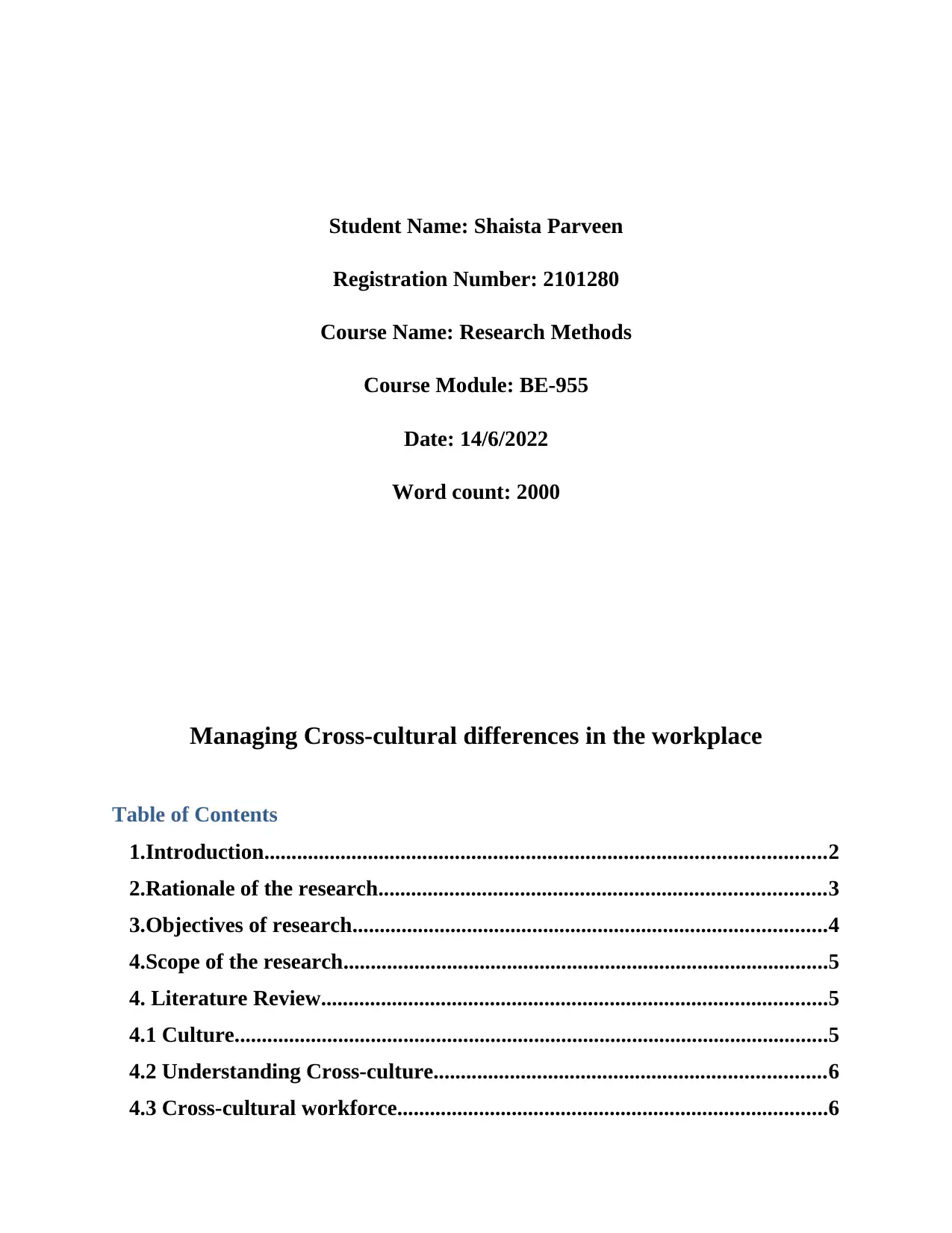
Student Name: Shaista Parveen
Registration Number: 2101280
Course Name: Research Methods
Course Module: BE-955
Date: 14/6/2022
Word count: 2000
Managing Cross-cultural differences in the workplace
Table of Contents
1.Introduction.......................................................................................................2
2.Rationale of the research..................................................................................3
3.Objectives of research.......................................................................................4
4.Scope of the research.........................................................................................5
4. Literature Review.............................................................................................5
4.1 Culture.............................................................................................................5
4.2 Understanding Cross-culture........................................................................6
4.3 Cross-cultural workforce...............................................................................6
Registration Number: 2101280
Course Name: Research Methods
Course Module: BE-955
Date: 14/6/2022
Word count: 2000
Managing Cross-cultural differences in the workplace
Table of Contents
1.Introduction.......................................................................................................2
2.Rationale of the research..................................................................................3
3.Objectives of research.......................................................................................4
4.Scope of the research.........................................................................................5
4. Literature Review.............................................................................................5
4.1 Culture.............................................................................................................5
4.2 Understanding Cross-culture........................................................................6
4.3 Cross-cultural workforce...............................................................................6
Paraphrase This Document
Need a fresh take? Get an instant paraphrase of this document with our AI Paraphraser
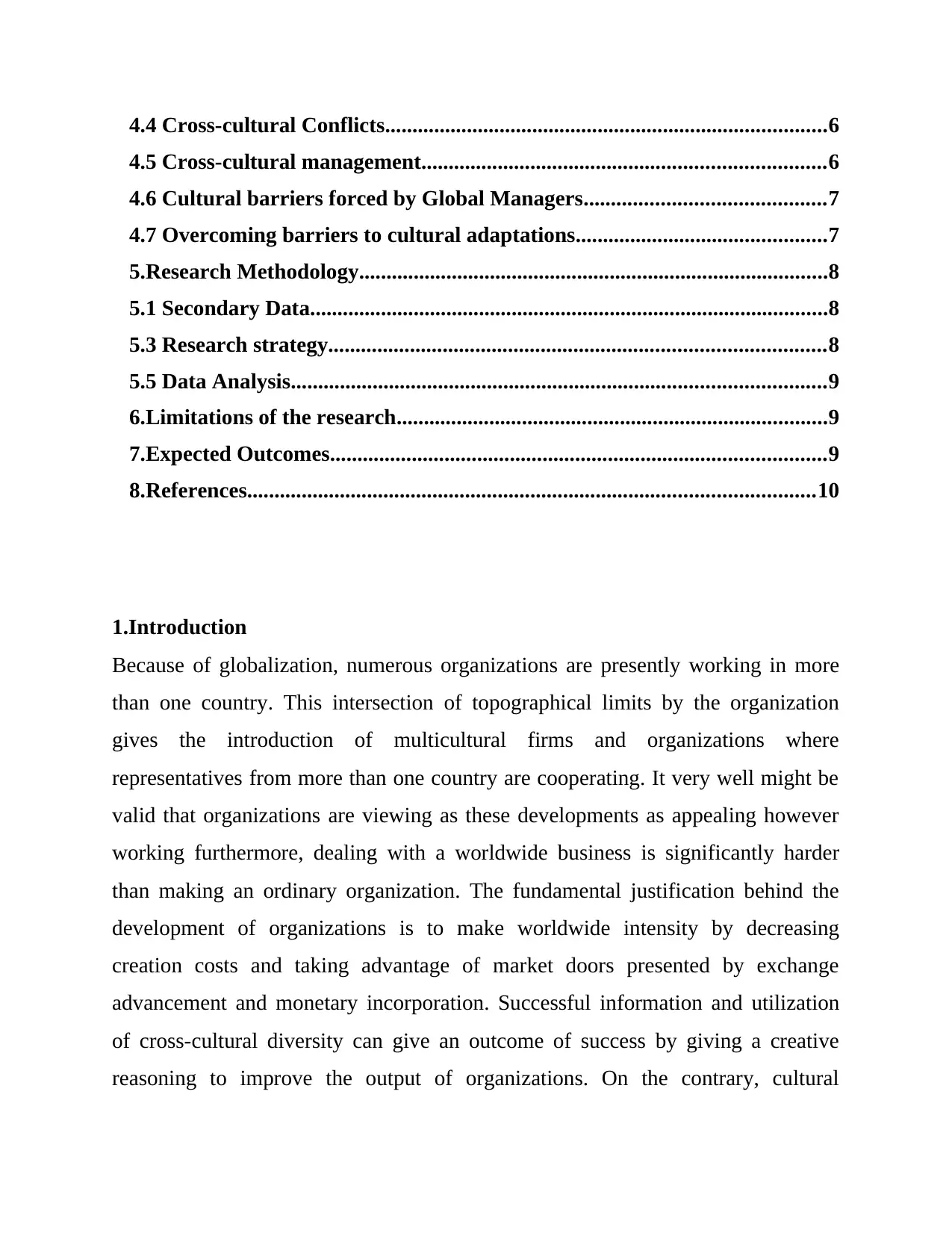
4.4 Cross-cultural Conflicts.................................................................................6
4.5 Cross-cultural management..........................................................................6
4.6 Cultural barriers forced by Global Managers............................................7
4.7 Overcoming barriers to cultural adaptations..............................................7
5.Research Methodology......................................................................................8
5.1 Secondary Data...............................................................................................8
5.3 Research strategy...........................................................................................8
5.5 Data Analysis..................................................................................................9
6.Limitations of the research...............................................................................9
7.Expected Outcomes...........................................................................................9
8.References........................................................................................................10
1.Introduction
Because of globalization, numerous organizations are presently working in more
than one country. This intersection of topographical limits by the organization
gives the introduction of multicultural firms and organizations where
representatives from more than one country are cooperating. It very well might be
valid that organizations are viewing as these developments as appealing however
working furthermore, dealing with a worldwide business is significantly harder
than making an ordinary organization. The fundamental justification behind the
development of organizations is to make worldwide intensity by decreasing
creation costs and taking advantage of market doors presented by exchange
advancement and monetary incorporation. Successful information and utilization
of cross-cultural diversity can give an outcome of success by giving a creative
reasoning to improve the output of organizations. On the contrary, cultural
4.5 Cross-cultural management..........................................................................6
4.6 Cultural barriers forced by Global Managers............................................7
4.7 Overcoming barriers to cultural adaptations..............................................7
5.Research Methodology......................................................................................8
5.1 Secondary Data...............................................................................................8
5.3 Research strategy...........................................................................................8
5.5 Data Analysis..................................................................................................9
6.Limitations of the research...............................................................................9
7.Expected Outcomes...........................................................................................9
8.References........................................................................................................10
1.Introduction
Because of globalization, numerous organizations are presently working in more
than one country. This intersection of topographical limits by the organization
gives the introduction of multicultural firms and organizations where
representatives from more than one country are cooperating. It very well might be
valid that organizations are viewing as these developments as appealing however
working furthermore, dealing with a worldwide business is significantly harder
than making an ordinary organization. The fundamental justification behind the
development of organizations is to make worldwide intensity by decreasing
creation costs and taking advantage of market doors presented by exchange
advancement and monetary incorporation. Successful information and utilization
of cross-cultural diversity can give an outcome of success by giving a creative
reasoning to improve the output of organizations. On the contrary, cultural
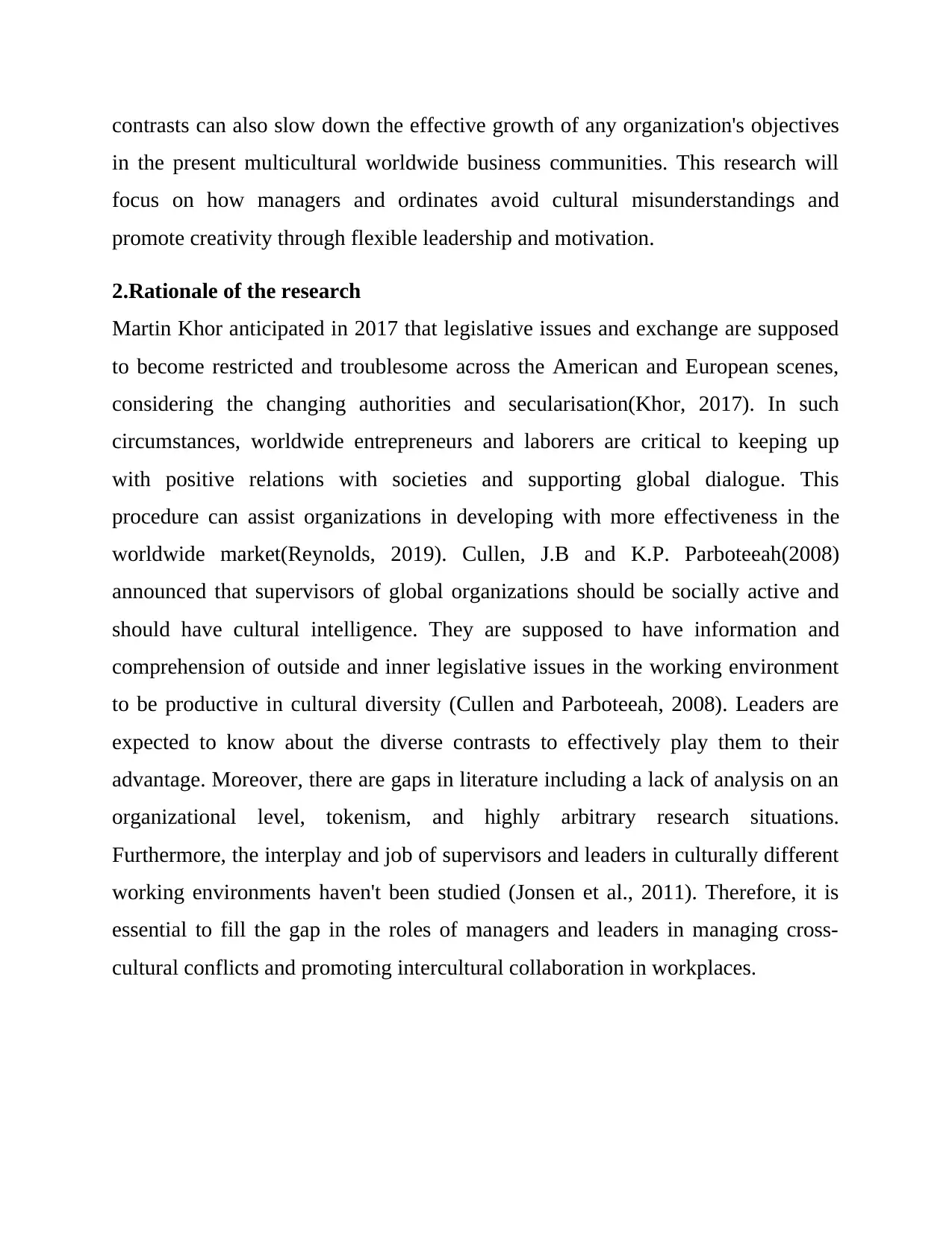
contrasts can also slow down the effective growth of any organization's objectives
in the present multicultural worldwide business communities. This research will
focus on how managers and ordinates avoid cultural misunderstandings and
promote creativity through flexible leadership and motivation.
2.Rationale of the research
Martin Khor anticipated in 2017 that legislative issues and exchange are supposed
to become restricted and troublesome across the American and European scenes,
considering the changing authorities and secularisation(Khor, 2017). In such
circumstances, worldwide entrepreneurs and laborers are critical to keeping up
with positive relations with societies and supporting global dialogue. This
procedure can assist organizations in developing with more effectiveness in the
worldwide market(Reynolds, 2019). Cullen, J.B and K.P. Parboteeah(2008)
announced that supervisors of global organizations should be socially active and
should have cultural intelligence. They are supposed to have information and
comprehension of outside and inner legislative issues in the working environment
to be productive in cultural diversity (Cullen and Parboteeah, 2008). Leaders are
expected to know about the diverse contrasts to effectively play them to their
advantage. Moreover, there are gaps in literature including a lack of analysis on an
organizational level, tokenism, and highly arbitrary research situations.
Furthermore, the interplay and job of supervisors and leaders in culturally different
working environments haven't been studied (Jonsen et al., 2011). Therefore, it is
essential to fill the gap in the roles of managers and leaders in managing cross-
cultural conflicts and promoting intercultural collaboration in workplaces.
in the present multicultural worldwide business communities. This research will
focus on how managers and ordinates avoid cultural misunderstandings and
promote creativity through flexible leadership and motivation.
2.Rationale of the research
Martin Khor anticipated in 2017 that legislative issues and exchange are supposed
to become restricted and troublesome across the American and European scenes,
considering the changing authorities and secularisation(Khor, 2017). In such
circumstances, worldwide entrepreneurs and laborers are critical to keeping up
with positive relations with societies and supporting global dialogue. This
procedure can assist organizations in developing with more effectiveness in the
worldwide market(Reynolds, 2019). Cullen, J.B and K.P. Parboteeah(2008)
announced that supervisors of global organizations should be socially active and
should have cultural intelligence. They are supposed to have information and
comprehension of outside and inner legislative issues in the working environment
to be productive in cultural diversity (Cullen and Parboteeah, 2008). Leaders are
expected to know about the diverse contrasts to effectively play them to their
advantage. Moreover, there are gaps in literature including a lack of analysis on an
organizational level, tokenism, and highly arbitrary research situations.
Furthermore, the interplay and job of supervisors and leaders in culturally different
working environments haven't been studied (Jonsen et al., 2011). Therefore, it is
essential to fill the gap in the roles of managers and leaders in managing cross-
cultural conflicts and promoting intercultural collaboration in workplaces.
⊘ This is a preview!⊘
Do you want full access?
Subscribe today to unlock all pages.

Trusted by 1+ million students worldwide
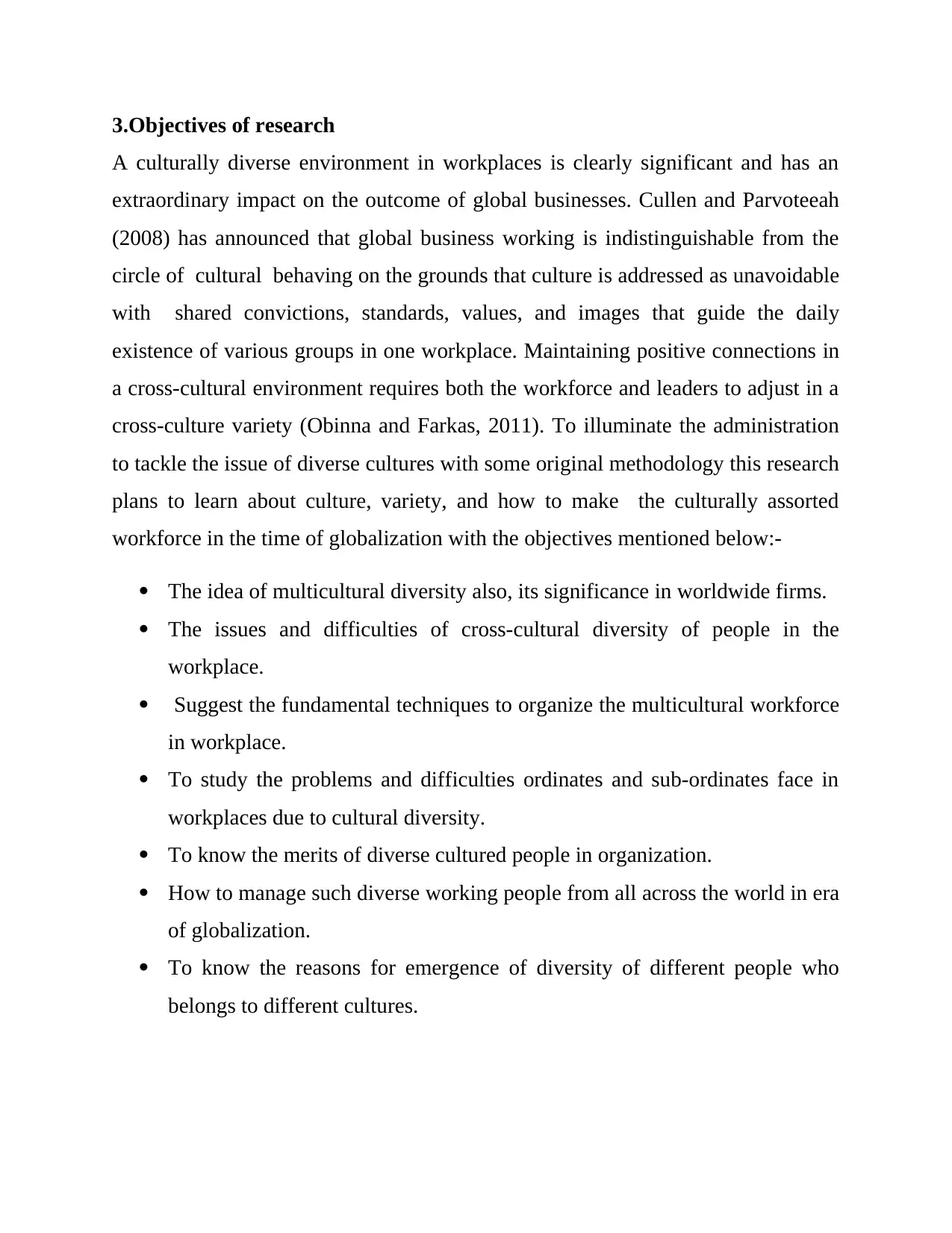
3.Objectives of research
A culturally diverse environment in workplaces is clearly significant and has an
extraordinary impact on the outcome of global businesses. Cullen and Parvoteeah
(2008) has announced that global business working is indistinguishable from the
circle of cultural behaving on the grounds that culture is addressed as unavoidable
with shared convictions, standards, values, and images that guide the daily
existence of various groups in one workplace. Maintaining positive connections in
a cross-cultural environment requires both the workforce and leaders to adjust in a
cross-culture variety (Obinna and Farkas, 2011). To illuminate the administration
to tackle the issue of diverse cultures with some original methodology this research
plans to learn about culture, variety, and how to make the culturally assorted
workforce in the time of globalization with the objectives mentioned below:-
The idea of multicultural diversity also, its significance in worldwide firms.
The issues and difficulties of cross-cultural diversity of people in the
workplace.
Suggest the fundamental techniques to organize the multicultural workforce
in workplace.
To study the problems and difficulties ordinates and sub-ordinates face in
workplaces due to cultural diversity.
To know the merits of diverse cultured people in organization.
How to manage such diverse working people from all across the world in era
of globalization.
To know the reasons for emergence of diversity of different people who
belongs to different cultures.
A culturally diverse environment in workplaces is clearly significant and has an
extraordinary impact on the outcome of global businesses. Cullen and Parvoteeah
(2008) has announced that global business working is indistinguishable from the
circle of cultural behaving on the grounds that culture is addressed as unavoidable
with shared convictions, standards, values, and images that guide the daily
existence of various groups in one workplace. Maintaining positive connections in
a cross-cultural environment requires both the workforce and leaders to adjust in a
cross-culture variety (Obinna and Farkas, 2011). To illuminate the administration
to tackle the issue of diverse cultures with some original methodology this research
plans to learn about culture, variety, and how to make the culturally assorted
workforce in the time of globalization with the objectives mentioned below:-
The idea of multicultural diversity also, its significance in worldwide firms.
The issues and difficulties of cross-cultural diversity of people in the
workplace.
Suggest the fundamental techniques to organize the multicultural workforce
in workplace.
To study the problems and difficulties ordinates and sub-ordinates face in
workplaces due to cultural diversity.
To know the merits of diverse cultured people in organization.
How to manage such diverse working people from all across the world in era
of globalization.
To know the reasons for emergence of diversity of different people who
belongs to different cultures.
Paraphrase This Document
Need a fresh take? Get an instant paraphrase of this document with our AI Paraphraser
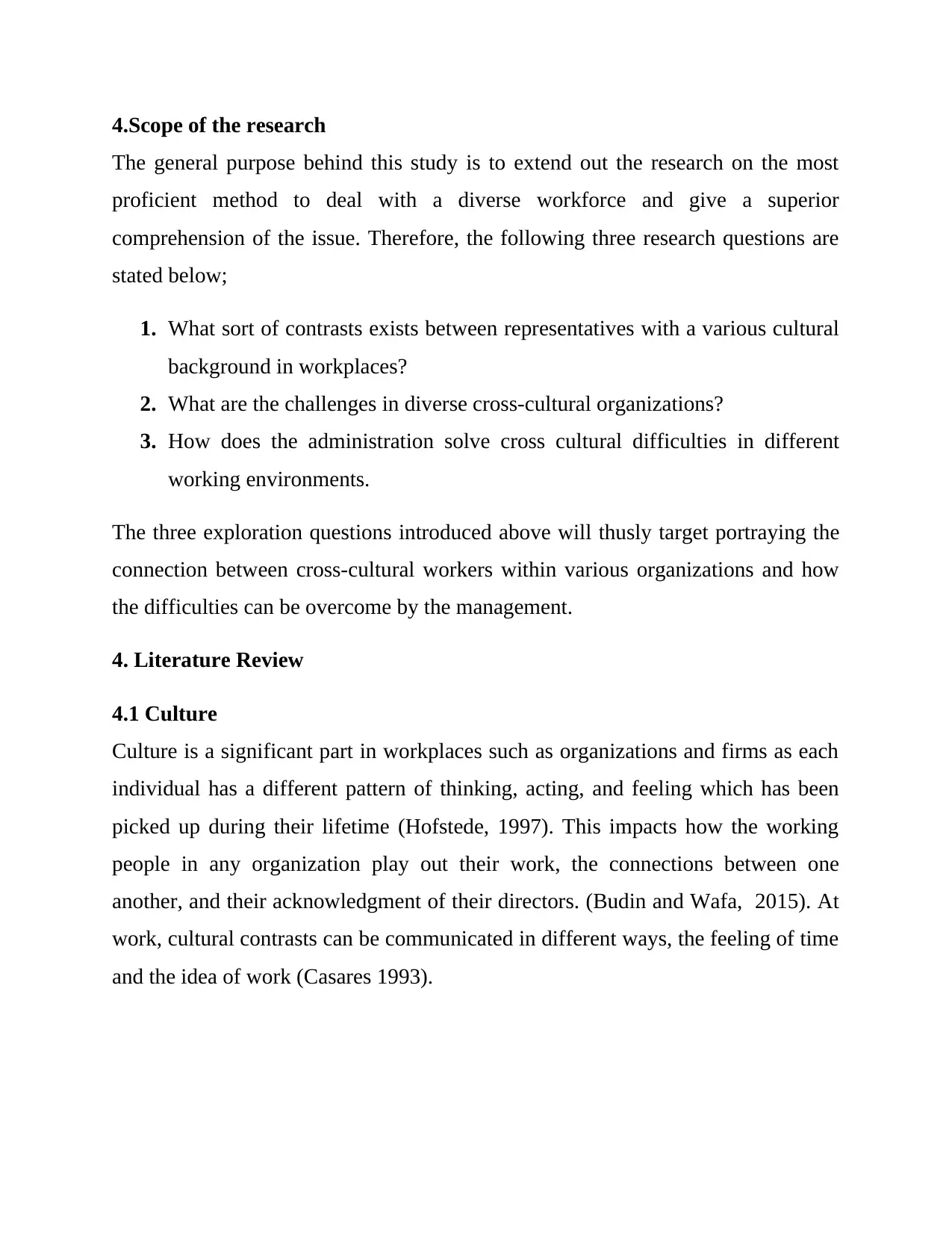
4.Scope of the research
The general purpose behind this study is to extend out the research on the most
proficient method to deal with a diverse workforce and give a superior
comprehension of the issue. Therefore, the following three research questions are
stated below;
1. What sort of contrasts exists between representatives with a various cultural
background in workplaces?
2. What are the challenges in diverse cross-cultural organizations?
3. How does the administration solve cross cultural difficulties in different
working environments.
The three exploration questions introduced above will thusly target portraying the
connection between cross-cultural workers within various organizations and how
the difficulties can be overcome by the management.
4. Literature Review
4.1 Culture
Culture is a significant part in workplaces such as organizations and firms as each
individual has a different pattern of thinking, acting, and feeling which has been
picked up during their lifetime (Hofstede, 1997). This impacts how the working
people in any organization play out their work, the connections between one
another, and their acknowledgment of their directors. (Budin and Wafa, 2015). At
work, cultural contrasts can be communicated in different ways, the feeling of time
and the idea of work (Casares 1993).
The general purpose behind this study is to extend out the research on the most
proficient method to deal with a diverse workforce and give a superior
comprehension of the issue. Therefore, the following three research questions are
stated below;
1. What sort of contrasts exists between representatives with a various cultural
background in workplaces?
2. What are the challenges in diverse cross-cultural organizations?
3. How does the administration solve cross cultural difficulties in different
working environments.
The three exploration questions introduced above will thusly target portraying the
connection between cross-cultural workers within various organizations and how
the difficulties can be overcome by the management.
4. Literature Review
4.1 Culture
Culture is a significant part in workplaces such as organizations and firms as each
individual has a different pattern of thinking, acting, and feeling which has been
picked up during their lifetime (Hofstede, 1997). This impacts how the working
people in any organization play out their work, the connections between one
another, and their acknowledgment of their directors. (Budin and Wafa, 2015). At
work, cultural contrasts can be communicated in different ways, the feeling of time
and the idea of work (Casares 1993).
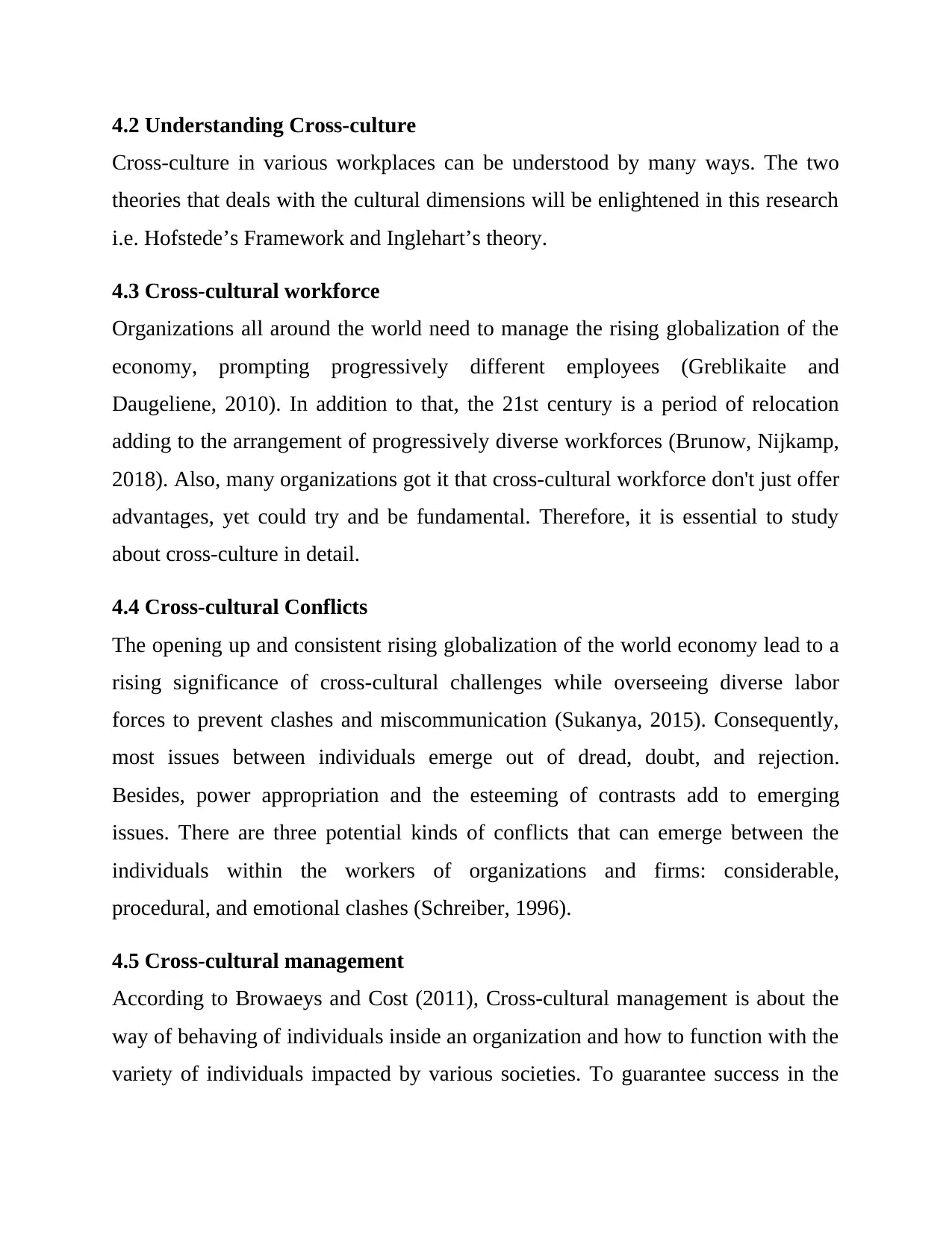
4.2 Understanding Cross-culture
Cross-culture in various workplaces can be understood by many ways. The two
theories that deals with the cultural dimensions will be enlightened in this research
i.e. Hofstede’s Framework and Inglehart’s theory.
4.3 Cross-cultural workforce
Organizations all around the world need to manage the rising globalization of the
economy, prompting progressively different employees (Greblikaite and
Daugeliene, 2010). In addition to that, the 21st century is a period of relocation
adding to the arrangement of progressively diverse workforces (Brunow, Nijkamp,
2018). Also, many organizations got it that cross-cultural workforce don't just offer
advantages, yet could try and be fundamental. Therefore, it is essential to study
about cross-culture in detail.
4.4 Cross-cultural Conflicts
The opening up and consistent rising globalization of the world economy lead to a
rising significance of cross-cultural challenges while overseeing diverse labor
forces to prevent clashes and miscommunication (Sukanya, 2015). Consequently,
most issues between individuals emerge out of dread, doubt, and rejection.
Besides, power appropriation and the esteeming of contrasts add to emerging
issues. There are three potential kinds of conflicts that can emerge between the
individuals within the workers of organizations and firms: considerable,
procedural, and emotional clashes (Schreiber, 1996).
4.5 Cross-cultural management
According to Browaeys and Cost (2011), Cross-cultural management is about the
way of behaving of individuals inside an organization and how to function with the
variety of individuals impacted by various societies. To guarantee success in the
Cross-culture in various workplaces can be understood by many ways. The two
theories that deals with the cultural dimensions will be enlightened in this research
i.e. Hofstede’s Framework and Inglehart’s theory.
4.3 Cross-cultural workforce
Organizations all around the world need to manage the rising globalization of the
economy, prompting progressively different employees (Greblikaite and
Daugeliene, 2010). In addition to that, the 21st century is a period of relocation
adding to the arrangement of progressively diverse workforces (Brunow, Nijkamp,
2018). Also, many organizations got it that cross-cultural workforce don't just offer
advantages, yet could try and be fundamental. Therefore, it is essential to study
about cross-culture in detail.
4.4 Cross-cultural Conflicts
The opening up and consistent rising globalization of the world economy lead to a
rising significance of cross-cultural challenges while overseeing diverse labor
forces to prevent clashes and miscommunication (Sukanya, 2015). Consequently,
most issues between individuals emerge out of dread, doubt, and rejection.
Besides, power appropriation and the esteeming of contrasts add to emerging
issues. There are three potential kinds of conflicts that can emerge between the
individuals within the workers of organizations and firms: considerable,
procedural, and emotional clashes (Schreiber, 1996).
4.5 Cross-cultural management
According to Browaeys and Cost (2011), Cross-cultural management is about the
way of behaving of individuals inside an organization and how to function with the
variety of individuals impacted by various societies. To guarantee success in the
⊘ This is a preview!⊘
Do you want full access?
Subscribe today to unlock all pages.

Trusted by 1+ million students worldwide
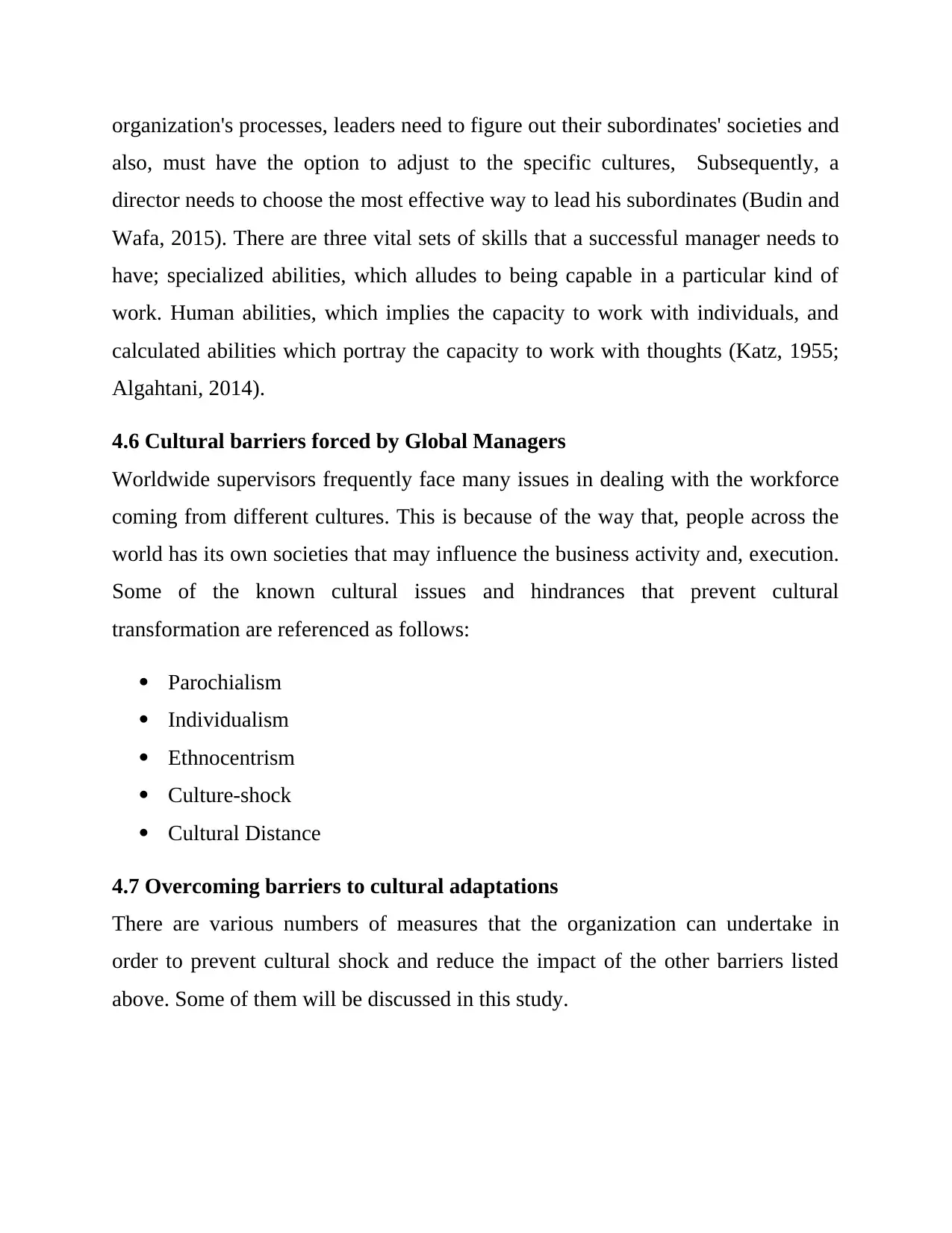
organization's processes, leaders need to figure out their subordinates' societies and
also, must have the option to adjust to the specific cultures, Subsequently, a
director needs to choose the most effective way to lead his subordinates (Budin and
Wafa, 2015). There are three vital sets of skills that a successful manager needs to
have; specialized abilities, which alludes to being capable in a particular kind of
work. Human abilities, which implies the capacity to work with individuals, and
calculated abilities which portray the capacity to work with thoughts (Katz, 1955;
Algahtani, 2014).
4.6 Cultural barriers forced by Global Managers
Worldwide supervisors frequently face many issues in dealing with the workforce
coming from different cultures. This is because of the way that, people across the
world has its own societies that may influence the business activity and, execution.
Some of the known cultural issues and hindrances that prevent cultural
transformation are referenced as follows:
Parochialism
Individualism
Ethnocentrism
Culture-shock
Cultural Distance
4.7 Overcoming barriers to cultural adaptations
There are various numbers of measures that the organization can undertake in
order to prevent cultural shock and reduce the impact of the other barriers listed
above. Some of them will be discussed in this study.
also, must have the option to adjust to the specific cultures, Subsequently, a
director needs to choose the most effective way to lead his subordinates (Budin and
Wafa, 2015). There are three vital sets of skills that a successful manager needs to
have; specialized abilities, which alludes to being capable in a particular kind of
work. Human abilities, which implies the capacity to work with individuals, and
calculated abilities which portray the capacity to work with thoughts (Katz, 1955;
Algahtani, 2014).
4.6 Cultural barriers forced by Global Managers
Worldwide supervisors frequently face many issues in dealing with the workforce
coming from different cultures. This is because of the way that, people across the
world has its own societies that may influence the business activity and, execution.
Some of the known cultural issues and hindrances that prevent cultural
transformation are referenced as follows:
Parochialism
Individualism
Ethnocentrism
Culture-shock
Cultural Distance
4.7 Overcoming barriers to cultural adaptations
There are various numbers of measures that the organization can undertake in
order to prevent cultural shock and reduce the impact of the other barriers listed
above. Some of them will be discussed in this study.
Paraphrase This Document
Need a fresh take? Get an instant paraphrase of this document with our AI Paraphraser
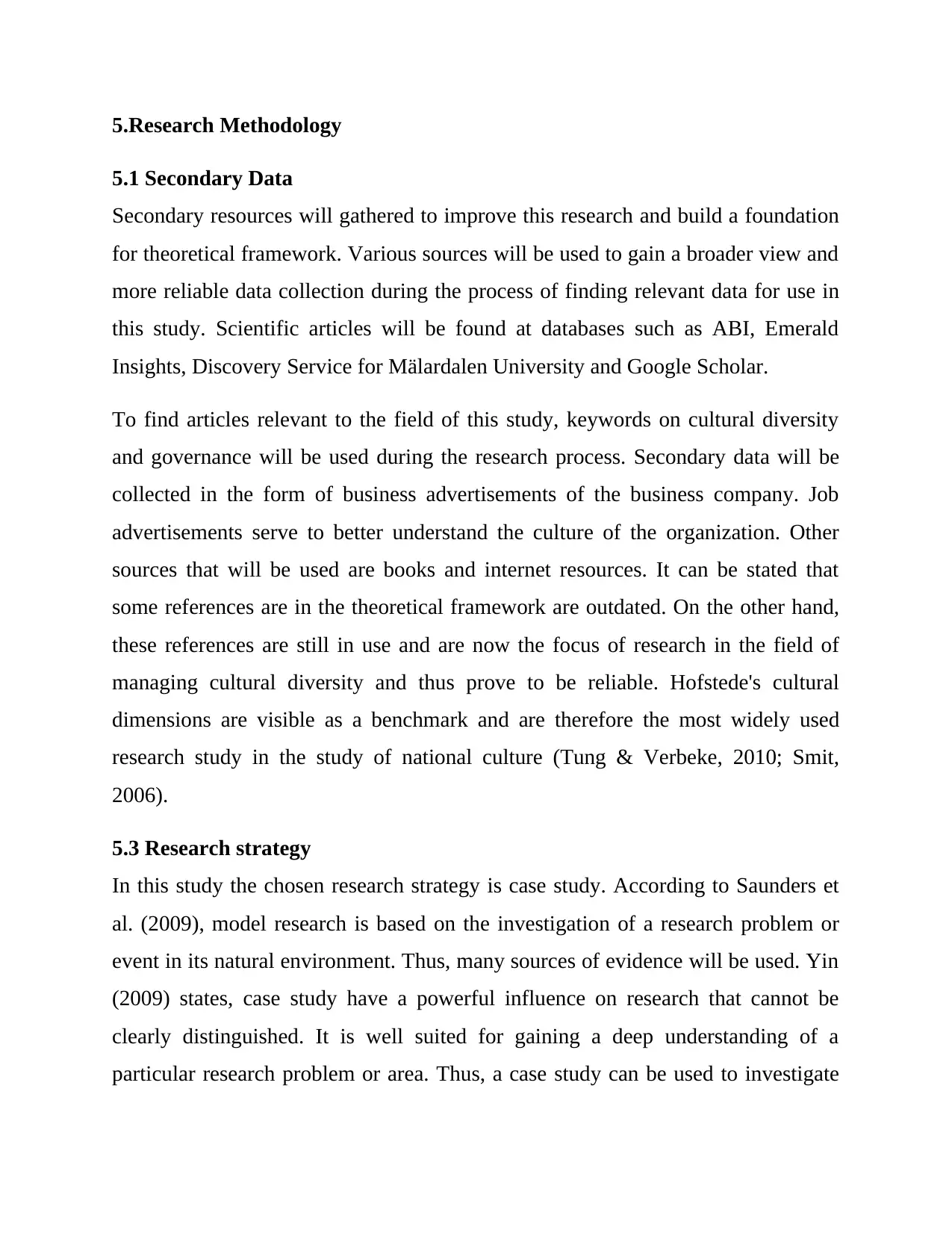
5.Research Methodology
5.1 Secondary Data
Secondary resources will gathered to improve this research and build a foundation
for theoretical framework. Various sources will be used to gain a broader view and
more reliable data collection during the process of finding relevant data for use in
this study. Scientific articles will be found at databases such as ABI, Emerald
Insights, Discovery Service for Mälardalen University and Google Scholar.
To find articles relevant to the field of this study, keywords on cultural diversity
and governance will be used during the research process. Secondary data will be
collected in the form of business advertisements of the business company. Job
advertisements serve to better understand the culture of the organization. Other
sources that will be used are books and internet resources. It can be stated that
some references are in the theoretical framework are outdated. On the other hand,
these references are still in use and are now the focus of research in the field of
managing cultural diversity and thus prove to be reliable. Hofstede's cultural
dimensions are visible as a benchmark and are therefore the most widely used
research study in the study of national culture (Tung & Verbeke, 2010; Smit,
2006).
5.3 Research strategy
In this study the chosen research strategy is case study. According to Saunders et
al. (2009), model research is based on the investigation of a research problem or
event in its natural environment. Thus, many sources of evidence will be used. Yin
(2009) states, case study have a powerful influence on research that cannot be
clearly distinguished. It is well suited for gaining a deep understanding of a
particular research problem or area. Thus, a case study can be used to investigate
5.1 Secondary Data
Secondary resources will gathered to improve this research and build a foundation
for theoretical framework. Various sources will be used to gain a broader view and
more reliable data collection during the process of finding relevant data for use in
this study. Scientific articles will be found at databases such as ABI, Emerald
Insights, Discovery Service for Mälardalen University and Google Scholar.
To find articles relevant to the field of this study, keywords on cultural diversity
and governance will be used during the research process. Secondary data will be
collected in the form of business advertisements of the business company. Job
advertisements serve to better understand the culture of the organization. Other
sources that will be used are books and internet resources. It can be stated that
some references are in the theoretical framework are outdated. On the other hand,
these references are still in use and are now the focus of research in the field of
managing cultural diversity and thus prove to be reliable. Hofstede's cultural
dimensions are visible as a benchmark and are therefore the most widely used
research study in the study of national culture (Tung & Verbeke, 2010; Smit,
2006).
5.3 Research strategy
In this study the chosen research strategy is case study. According to Saunders et
al. (2009), model research is based on the investigation of a research problem or
event in its natural environment. Thus, many sources of evidence will be used. Yin
(2009) states, case study have a powerful influence on research that cannot be
clearly distinguished. It is well suited for gaining a deep understanding of a
particular research problem or area. Thus, a case study can be used to investigate
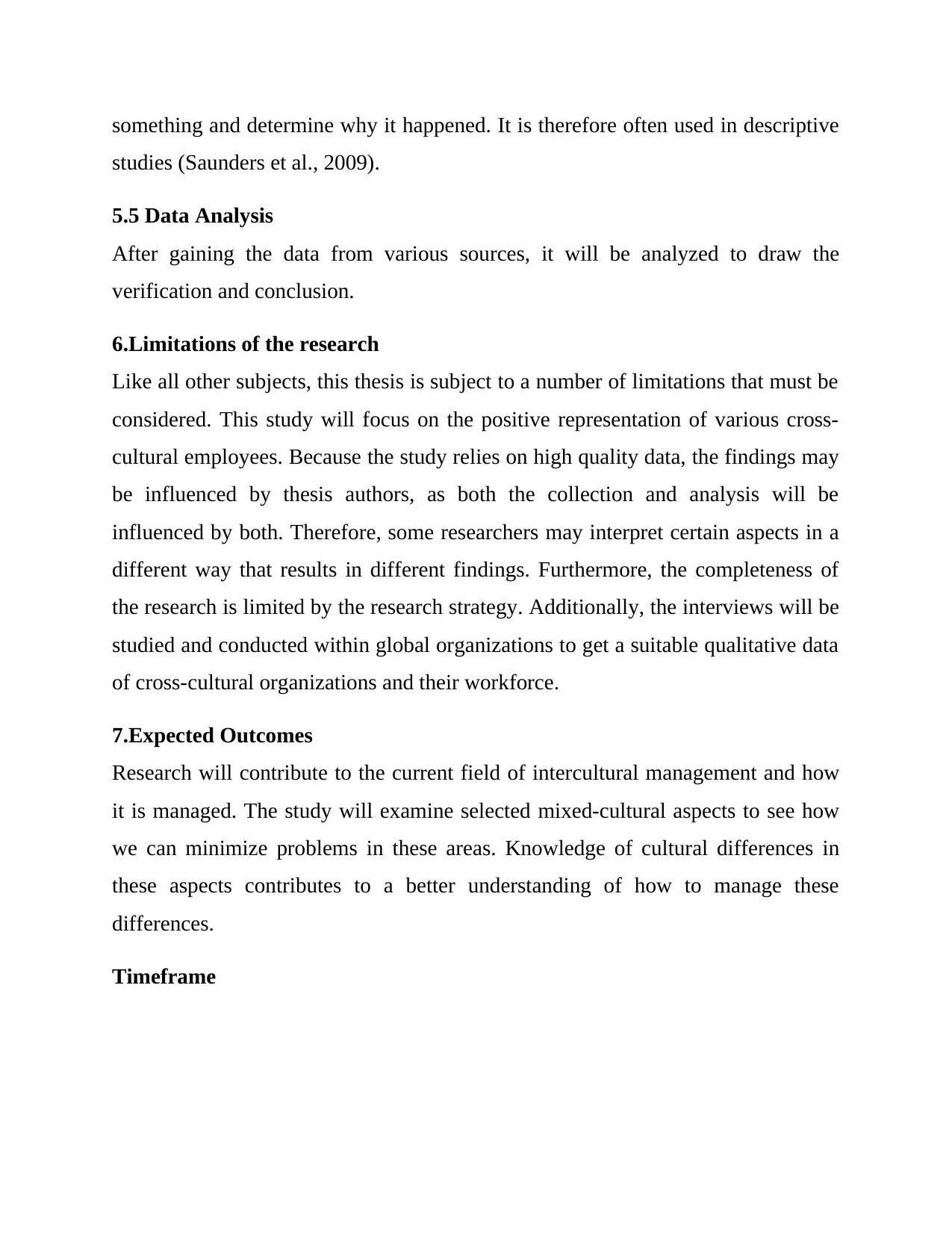
something and determine why it happened. It is therefore often used in descriptive
studies (Saunders et al., 2009).
5.5 Data Analysis
After gaining the data from various sources, it will be analyzed to draw the
verification and conclusion.
6.Limitations of the research
Like all other subjects, this thesis is subject to a number of limitations that must be
considered. This study will focus on the positive representation of various cross-
cultural employees. Because the study relies on high quality data, the findings may
be influenced by thesis authors, as both the collection and analysis will be
influenced by both. Therefore, some researchers may interpret certain aspects in a
different way that results in different findings. Furthermore, the completeness of
the research is limited by the research strategy. Additionally, the interviews will be
studied and conducted within global organizations to get a suitable qualitative data
of cross-cultural organizations and their workforce.
7.Expected Outcomes
Research will contribute to the current field of intercultural management and how
it is managed. The study will examine selected mixed-cultural aspects to see how
we can minimize problems in these areas. Knowledge of cultural differences in
these aspects contributes to a better understanding of how to manage these
differences.
Timeframe
studies (Saunders et al., 2009).
5.5 Data Analysis
After gaining the data from various sources, it will be analyzed to draw the
verification and conclusion.
6.Limitations of the research
Like all other subjects, this thesis is subject to a number of limitations that must be
considered. This study will focus on the positive representation of various cross-
cultural employees. Because the study relies on high quality data, the findings may
be influenced by thesis authors, as both the collection and analysis will be
influenced by both. Therefore, some researchers may interpret certain aspects in a
different way that results in different findings. Furthermore, the completeness of
the research is limited by the research strategy. Additionally, the interviews will be
studied and conducted within global organizations to get a suitable qualitative data
of cross-cultural organizations and their workforce.
7.Expected Outcomes
Research will contribute to the current field of intercultural management and how
it is managed. The study will examine selected mixed-cultural aspects to see how
we can minimize problems in these areas. Knowledge of cultural differences in
these aspects contributes to a better understanding of how to manage these
differences.
Timeframe
⊘ This is a preview!⊘
Do you want full access?
Subscribe today to unlock all pages.

Trusted by 1+ million students worldwide
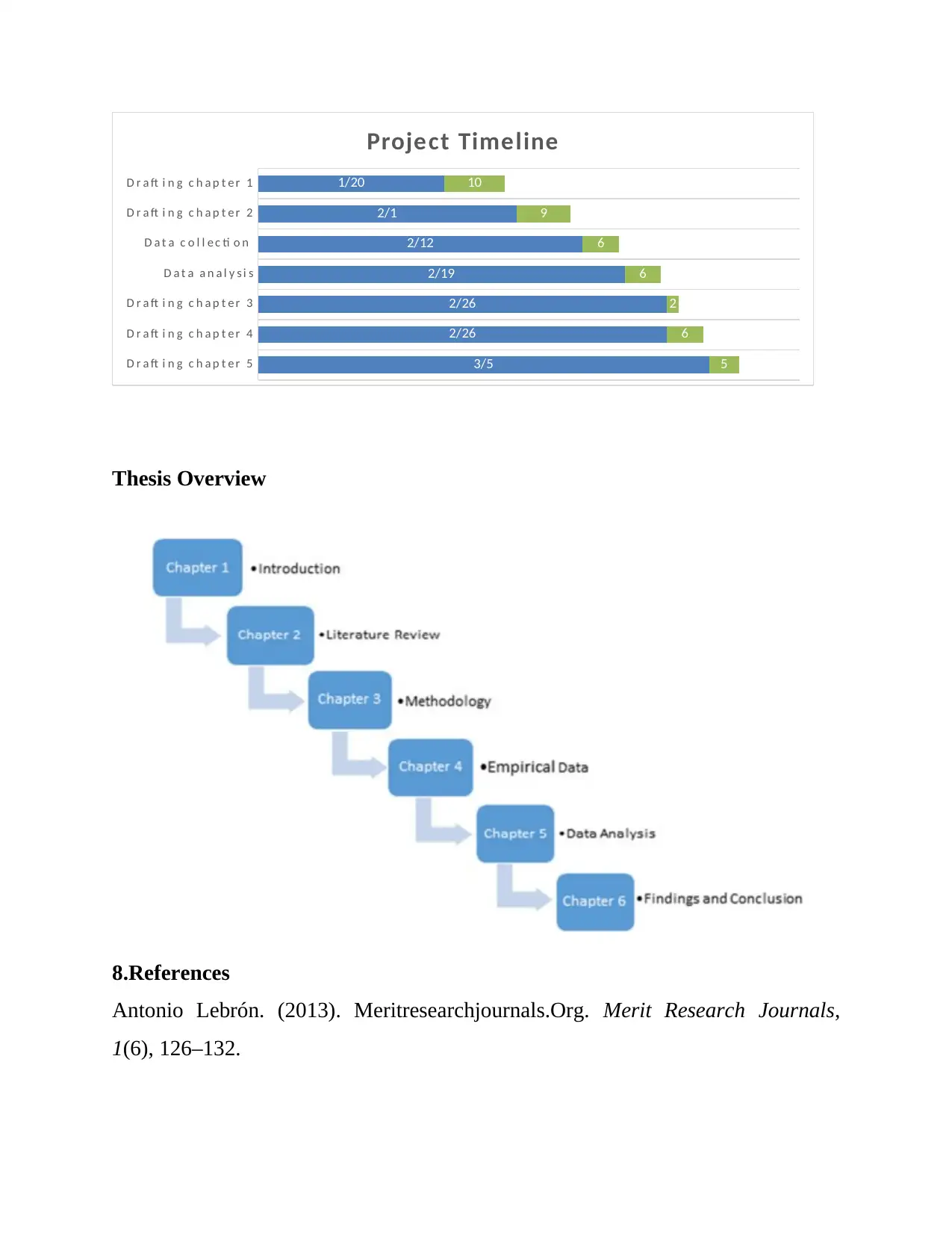
D r a ft i n g c h a p t e r 1
D r a ft i n g c h a p t e r 2
D a t a c o l l e c ti o n
D a t a a n a l y s i s
D r a ft i n g c h a p t e r 3
D r a ft i n g c h a p t e r 4
D r a ft i n g c h a p t e r 5
1/20
2/1
2/12
2/19
2/26
2/26
3/5
10
9
6
6
2
6
5
Project Timeline
Thesis Overview
8.References
Antonio Lebrón. (2013). Meritresearchjournals.Org. Merit Research Journals,
1(6), 126–132.
D r a ft i n g c h a p t e r 2
D a t a c o l l e c ti o n
D a t a a n a l y s i s
D r a ft i n g c h a p t e r 3
D r a ft i n g c h a p t e r 4
D r a ft i n g c h a p t e r 5
1/20
2/1
2/12
2/19
2/26
2/26
3/5
10
9
6
6
2
6
5
Project Timeline
Thesis Overview
8.References
Antonio Lebrón. (2013). Meritresearchjournals.Org. Merit Research Journals,
1(6), 126–132.
Paraphrase This Document
Need a fresh take? Get an instant paraphrase of this document with our AI Paraphraser
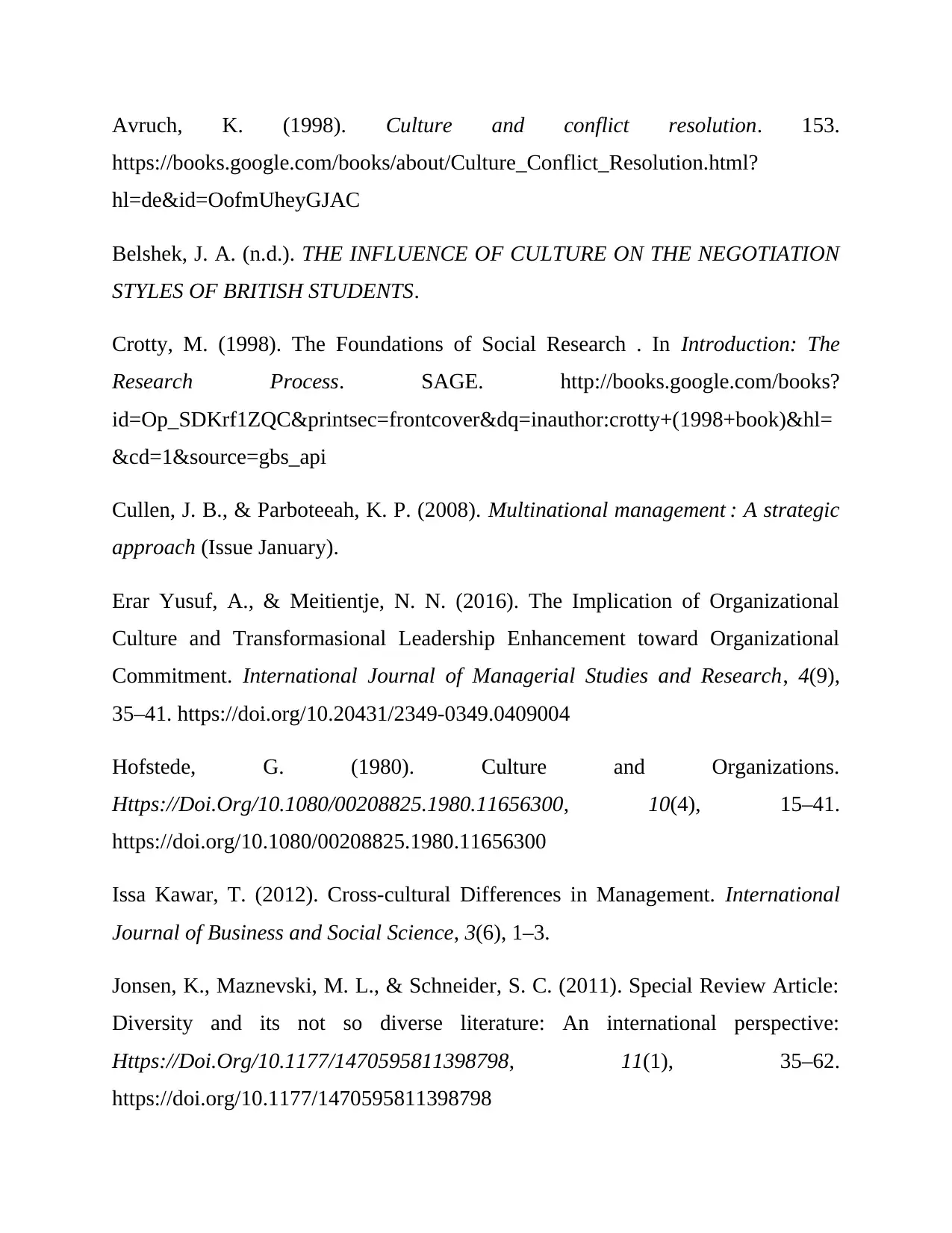
Avruch, K. (1998). Culture and conflict resolution. 153.
https://books.google.com/books/about/Culture_Conflict_Resolution.html?
hl=de&id=OofmUheyGJAC
Belshek, J. A. (n.d.). THE INFLUENCE OF CULTURE ON THE NEGOTIATION
STYLES OF BRITISH STUDENTS.
Crotty, M. (1998). The Foundations of Social Research . In Introduction: The
Research Process. SAGE. http://books.google.com/books?
id=Op_SDKrf1ZQC&printsec=frontcover&dq=inauthor:crotty+(1998+book)&hl=
&cd=1&source=gbs_api
Cullen, J. B., & Parboteeah, K. P. (2008). Multinational management : A strategic
approach (Issue January).
Erar Yusuf, A., & Meitientje, N. N. (2016). The Implication of Organizational
Culture and Transformasional Leadership Enhancement toward Organizational
Commitment. International Journal of Managerial Studies and Research, 4(9),
35–41. https://doi.org/10.20431/2349-0349.0409004
Hofstede, G. (1980). Culture and Organizations.
Https://Doi.Org/10.1080/00208825.1980.11656300, 10(4), 15–41.
https://doi.org/10.1080/00208825.1980.11656300
Issa Kawar, T. (2012). Cross-cultural Differences in Management. International
Journal of Business and Social Science, 3(6), 1–3.
Jonsen, K., Maznevski, M. L., & Schneider, S. C. (2011). Special Review Article:
Diversity and its not so diverse literature: An international perspective:
Https://Doi.Org/10.1177/1470595811398798, 11(1), 35–62.
https://doi.org/10.1177/1470595811398798
https://books.google.com/books/about/Culture_Conflict_Resolution.html?
hl=de&id=OofmUheyGJAC
Belshek, J. A. (n.d.). THE INFLUENCE OF CULTURE ON THE NEGOTIATION
STYLES OF BRITISH STUDENTS.
Crotty, M. (1998). The Foundations of Social Research . In Introduction: The
Research Process. SAGE. http://books.google.com/books?
id=Op_SDKrf1ZQC&printsec=frontcover&dq=inauthor:crotty+(1998+book)&hl=
&cd=1&source=gbs_api
Cullen, J. B., & Parboteeah, K. P. (2008). Multinational management : A strategic
approach (Issue January).
Erar Yusuf, A., & Meitientje, N. N. (2016). The Implication of Organizational
Culture and Transformasional Leadership Enhancement toward Organizational
Commitment. International Journal of Managerial Studies and Research, 4(9),
35–41. https://doi.org/10.20431/2349-0349.0409004
Hofstede, G. (1980). Culture and Organizations.
Https://Doi.Org/10.1080/00208825.1980.11656300, 10(4), 15–41.
https://doi.org/10.1080/00208825.1980.11656300
Issa Kawar, T. (2012). Cross-cultural Differences in Management. International
Journal of Business and Social Science, 3(6), 1–3.
Jonsen, K., Maznevski, M. L., & Schneider, S. C. (2011). Special Review Article:
Diversity and its not so diverse literature: An international perspective:
Https://Doi.Org/10.1177/1470595811398798, 11(1), 35–62.
https://doi.org/10.1177/1470595811398798
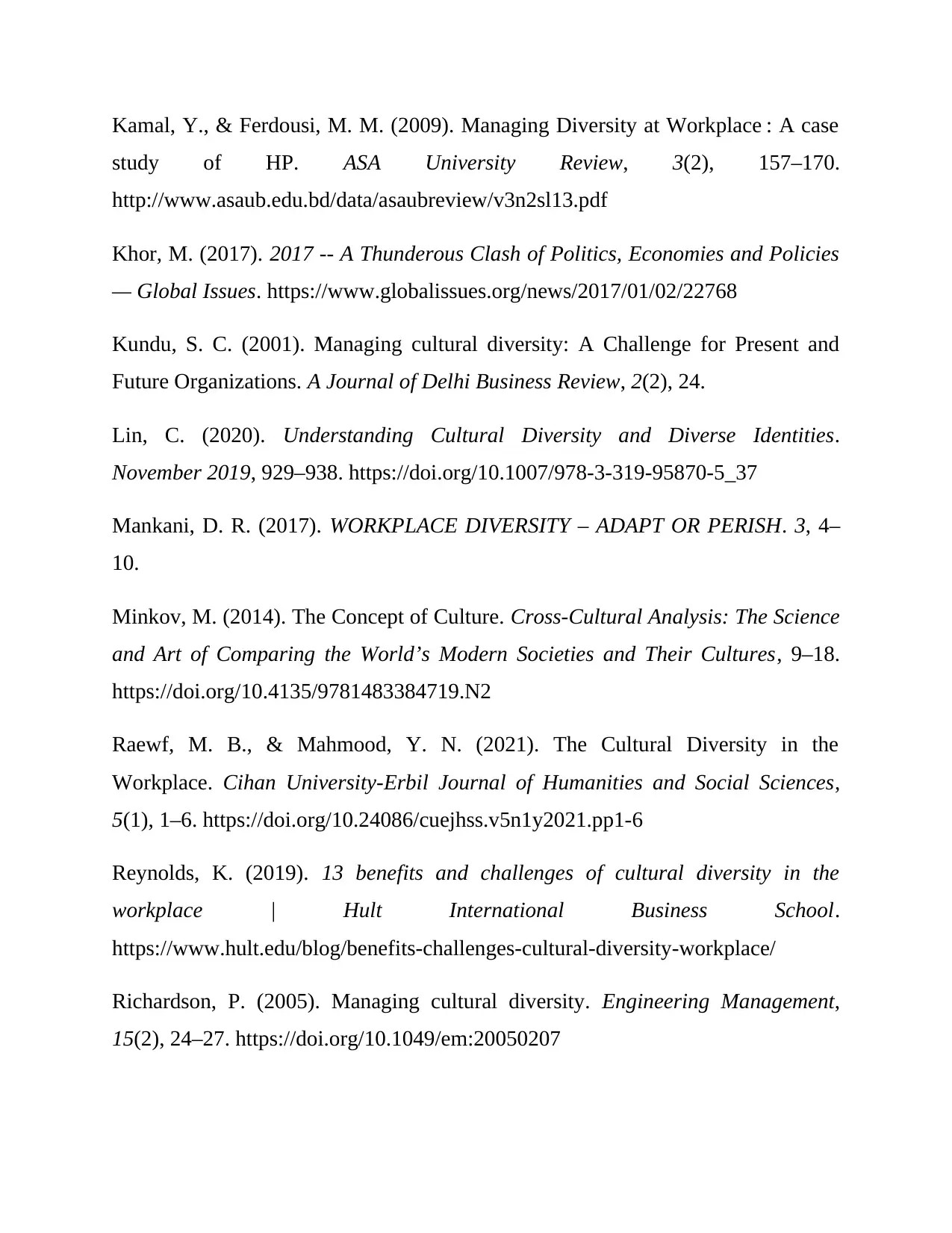
Kamal, Y., & Ferdousi, M. M. (2009). Managing Diversity at Workplace : A case
study of HP. ASA University Review, 3(2), 157–170.
http://www.asaub.edu.bd/data/asaubreview/v3n2sl13.pdf
Khor, M. (2017). 2017 -- A Thunderous Clash of Politics, Economies and Policies
— Global Issues. https://www.globalissues.org/news/2017/01/02/22768
Kundu, S. C. (2001). Managing cultural diversity: A Challenge for Present and
Future Organizations. A Journal of Delhi Business Review, 2(2), 24.
Lin, C. (2020). Understanding Cultural Diversity and Diverse Identities.
November 2019, 929–938. https://doi.org/10.1007/978-3-319-95870-5_37
Mankani, D. R. (2017). WORKPLACE DIVERSITY – ADAPT OR PERISH. 3, 4–
10.
Minkov, M. (2014). The Concept of Culture. Cross-Cultural Analysis: The Science
and Art of Comparing the World’s Modern Societies and Their Cultures, 9–18.
https://doi.org/10.4135/9781483384719.N2
Raewf, M. B., & Mahmood, Y. N. (2021). The Cultural Diversity in the
Workplace. Cihan University-Erbil Journal of Humanities and Social Sciences,
5(1), 1–6. https://doi.org/10.24086/cuejhss.v5n1y2021.pp1-6
Reynolds, K. (2019). 13 benefits and challenges of cultural diversity in the
workplace | Hult International Business School.
https://www.hult.edu/blog/benefits-challenges-cultural-diversity-workplace/
Richardson, P. (2005). Managing cultural diversity. Engineering Management,
15(2), 24–27. https://doi.org/10.1049/em:20050207
study of HP. ASA University Review, 3(2), 157–170.
http://www.asaub.edu.bd/data/asaubreview/v3n2sl13.pdf
Khor, M. (2017). 2017 -- A Thunderous Clash of Politics, Economies and Policies
— Global Issues. https://www.globalissues.org/news/2017/01/02/22768
Kundu, S. C. (2001). Managing cultural diversity: A Challenge for Present and
Future Organizations. A Journal of Delhi Business Review, 2(2), 24.
Lin, C. (2020). Understanding Cultural Diversity and Diverse Identities.
November 2019, 929–938. https://doi.org/10.1007/978-3-319-95870-5_37
Mankani, D. R. (2017). WORKPLACE DIVERSITY – ADAPT OR PERISH. 3, 4–
10.
Minkov, M. (2014). The Concept of Culture. Cross-Cultural Analysis: The Science
and Art of Comparing the World’s Modern Societies and Their Cultures, 9–18.
https://doi.org/10.4135/9781483384719.N2
Raewf, M. B., & Mahmood, Y. N. (2021). The Cultural Diversity in the
Workplace. Cihan University-Erbil Journal of Humanities and Social Sciences,
5(1), 1–6. https://doi.org/10.24086/cuejhss.v5n1y2021.pp1-6
Reynolds, K. (2019). 13 benefits and challenges of cultural diversity in the
workplace | Hult International Business School.
https://www.hult.edu/blog/benefits-challenges-cultural-diversity-workplace/
Richardson, P. (2005). Managing cultural diversity. Engineering Management,
15(2), 24–27. https://doi.org/10.1049/em:20050207
⊘ This is a preview!⊘
Do you want full access?
Subscribe today to unlock all pages.

Trusted by 1+ million students worldwide
1 out of 13
Related Documents
Your All-in-One AI-Powered Toolkit for Academic Success.
+13062052269
info@desklib.com
Available 24*7 on WhatsApp / Email
![[object Object]](/_next/static/media/star-bottom.7253800d.svg)
Unlock your academic potential
Copyright © 2020–2025 A2Z Services. All Rights Reserved. Developed and managed by ZUCOL.





